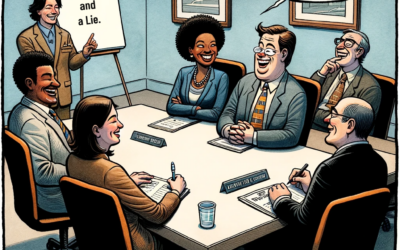What is more important to team performance, being on the right page or being on the same page? Many business journals celebrate those who continue to make the “right” decisions. We applaud the captains of industry who get things right every time (even if we have our doubts). Maybe, though, we shouldn’t be applauding their decision-making. Maybe we should be applauding their ability to get buy-in instead.
With the benefit of hindsight, any single decision can appear right or wrong. The problem is that our brains then completely assume the “right” answer is the ONE way to solve the problem. But how often do you look back and consider what other equally good choices might have worked?
Oftentimes, there is more than one “right” answer. And even the “wrong” answer (or the “less right” one) can work well if everyone understands and commits to it.
Consider for a moment a decision that didn’t work. What went wrong? Was it an execution error, or did you not have enough information? Did you have trouble getting people to follow through on the decision? Were there implementation problems? Was there a bottleneck somewhere in the system or another limiting element that you didn’t see until it was too late?
If we had all the information or “Steve” wouldn’t have screwed it up by taking too long to implement, it would have worked, you might be saying. Both of these things are likely out of your control. In complex environments, most of the reasons why decisions don’t work are out of our control. That’s important to realize. But it doesn’t mean we’re doomed. It means that much as we’d like to have the right answer, long-term success is more likely to happen if we focus on the things we can control. And the single biggest thing we can control is making sure we’re on the same page.
When trying to get things done with your team, focus on clarity and alignment instead of correctness. Clarity and alignment often lead to correctness, but correctness does not necessarily lead to clarity and alignment.
If you are honest with yourself, most of the problems you’re solving for on a daily basis have many possible solutions. There are often literally dozens, even hundreds of workable solutions to any given situation. Most of those situations are far too complex and unpredictable for us to categorically KNOW which one will work the best before we try them. Our brain likes to spot and solve for patterns, and that can make us think that we’ve got THE best answer when in reality we’ve just got a single one.
If we all walk out of the conference room misaligned even a little bit, the best answer in the world will fail miserably. So it’s as important, if not more so, to get on the same page than to get the best answer.
Here are three ways to get your team on the same page:
- Practice humility and vulnerability.
Instead of making a strong (and stubborn) case for your solution, practice saying something like this in team sessions: “I have a hunch that it’s ______, but I’m open to learning how I’ve got it wrong or how it could be better.” This shows not only your humility (while displaying some vulnerability) but also creates a space for others to impact you and share in ownership of the solution.
- Get very clear, set some limits, and run a test.
Once you’ve got a general agreement, stress-test it. Here are some questions to ask:
- Do we all completely understand what we’re being asked to do in this situation?
- Do we know what success looks like?
- Do we know what breakdown conditions look like?
- Do we have a clear sense of how long we’re running this test?
Everyone should be able to communicate (orally or on the page) what it is they’re being asked to do and why, as well as recognize signs of trouble and know what to do under these circumstances. Remember that much of the frustration from decisions not working is finding out afterwards that some people didn’t really understand and so didn’t help make things successful. Setting guardrails allows people to feel safe and more inclined to do their part.
- Celebrate the value of having gotten aligned—especially if it doesn’t work!
We could all do a better job using a postmortem process to learn from mistakes and failed tests. It’s often touchy and challenging to do so with our egos on the line. Celebrating work on alignment and clarity can help reinforce the practice going forward. It might sound like this, “Well, that didn’t go like we had hoped, and we’re going to have to try another solution, but I want to recognize that everyone was committed to the decision and we definitely learned what doesn’t work as a result. Progress was made.”
Of course it’s nice to be on the right page and to strive for the best possible decision or solution. But don’t let these impulses and desires obscure what’s more important: being on the same page. When you’re on the same page, you’re more likely to be heading in the right direction.



